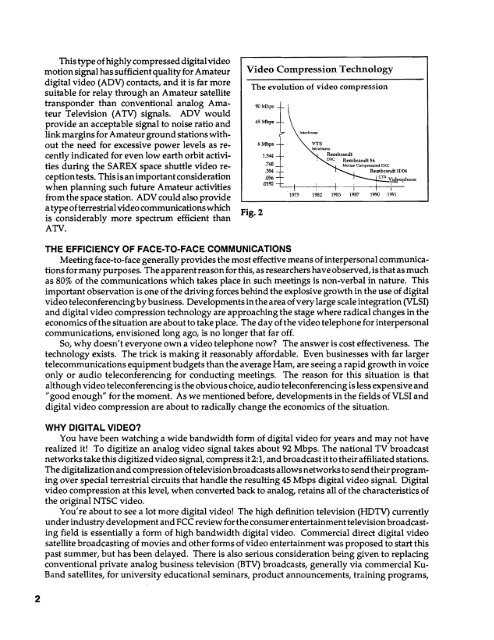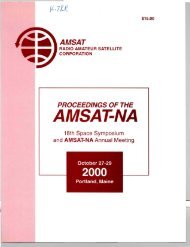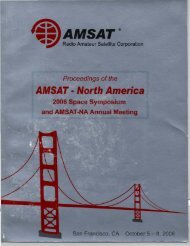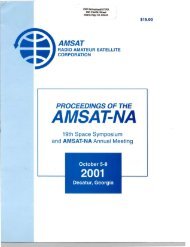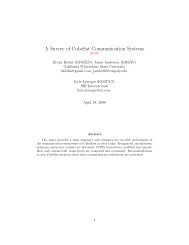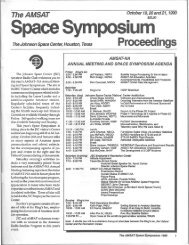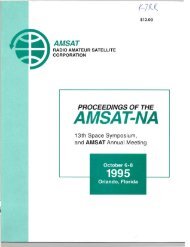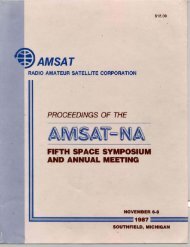November 8-10, 1991 - Klofas.com
November 8-10, 1991 - Klofas.com
November 8-10, 1991 - Klofas.com
You also want an ePaper? Increase the reach of your titles
YUMPU automatically turns print PDFs into web optimized ePapers that Google loves.
This type of highly <strong>com</strong>pressed digital video<br />
motion signal has sufficient quality for Amateur<br />
digital video (ADV) contacts, and it is far more<br />
suitable for relay through an Amateur satellite<br />
transponder than conventional analog Amateur<br />
Television (ATV) signals. ADV would<br />
provide an acceptable signal to noise ratio and<br />
link margins for Amateur ground stations without<br />
the need for excessive power levels as recently<br />
indicated for even low earth orbit activities<br />
during the SAREX space shuttle video reception<br />
tests. This is animportant consideration<br />
when planning such future Amateur activities<br />
from the space station. ADV could also provide<br />
a type ofterrestrial video <strong>com</strong>munications which<br />
is considerably more spectrum efficient than<br />
ATV.<br />
Video Compression Technology <br />
The evolution of video <strong>com</strong>pression <br />
Fig. 2<br />
90Mbps<br />
45Mbps<br />
6Mbps<br />
1.544<br />
!nt:nframc<br />
Rembrandt<br />
Rembrandt 56<br />
Motion Compensated DXC<br />
,768<br />
,354 Rembrandtll<strong>10</strong>6<br />
.056<br />
.0192<br />
ax Videophone<br />
I<br />
'1975 1982 1985 1987 ]990 <strong>1991</strong><br />
THE EFFICIENCY OF FACE-TO-FACE COMMUNICATIONS<br />
Meeting face-to-face generally provides the most effective means of interpersonal <strong>com</strong>munications<br />
for many purposes. The apparent reason for this, as researchers have observed, is that as much<br />
as 80% of the <strong>com</strong>munications which takes place in such meetings is non-verbal in nature. This<br />
important observation is one of the driving forces behind the explosive growth in the use of digital<br />
video teleconferencing bybusiness. Developments in the area of very large scale integration (VL5I)<br />
and digital video <strong>com</strong>pression technology are approaching the stage where radical changes in the<br />
economics ofthe situation are about to take place. The day of the video telephone for interpersonal<br />
<strong>com</strong>munications, envisioned long ago, is no longer that far off.<br />
So, why doesn't everyone own a video telephone now? The answer is cost effectiveness. The<br />
technology exists. The trick is making it reasonably affordable. Even businesses with far larger<br />
tele<strong>com</strong>munications equipment budgets than the average Ham, are seeing a rapid growth in voice<br />
only or audio teleconferencing for conducting meetings. The reason for this situation is that<br />
although video teleconferencing is the obvious choice, audio teleconferencing is less expensive and<br />
IIgood enough" for the moment. As we mentioned before, developments in the fields of VL51 and<br />
digital video <strong>com</strong>pression are about to radically change the economics of the situation.<br />
WHY DIGITAL VIDEO?<br />
You have been watching a wide bandwidth form of digital video for years and may not have<br />
realized it! To digitize an analog video signal takes about 92 Mbps. The national TV broadcast<br />
networks take this digitized video Signal, <strong>com</strong>press it 2:1, and broadcast it totheir affiliated stations.<br />
The digitalization and <strong>com</strong> pression of television broadcasts allows networks to send their programing<br />
over special terrestrial circuits that handle the resulting 45 Mbps digital video signal. Digital<br />
video <strong>com</strong>pression at this level, when converted back to analog, retains all of the characteristics of<br />
the original NT5C video.<br />
You're about to see a lot more digital video! The high definition television (HDTV) currently<br />
under ind ustry development and FCC review for the consumer entertainment television broadcasting<br />
field is essentially a form of high bandwidth digital video. Commercial direct digital video<br />
satellite broadcasting of movies and other forms of video entertainment was proposed to start this<br />
past summer, but has been delayed. There is also serious consideration being given to replacing<br />
conventional private analog business television (BTV) broadcasts, generally via <strong>com</strong>mercial Ku<br />
Band satellites, for university educational seminars, product announcements, training programs,<br />
2


